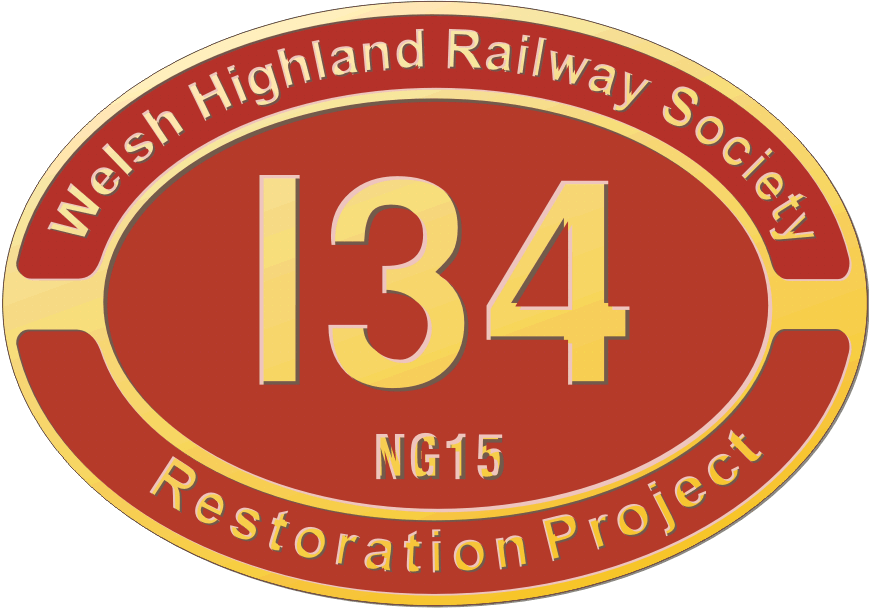
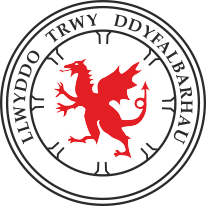 

|
 |
|
| Back to archived working party reports |
Christmas - New Year (December) 2022 Working Party
With the Christmas celebrations out of the way quite a few of the team spent some time at Dinas between the 27th and 30th December working on №134 before returning back home for the start of New Year.
Much was achieved over the four day period, although with much of the work concentrated around the workshops on various new components needed, and refurbishing old ones. One of the old ones to be cleaned and sent away for further remedial work was the manhole cover for the boiler's cladding. This is in somewhat of a decayed state so further work is needed on it!
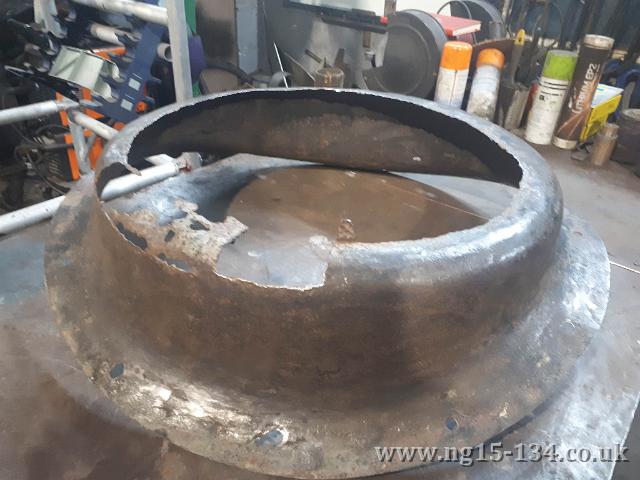 |
The manhole cover for the boiler's cladding after cleaning but in need of some further attention!!
Also in the workshops Erle has been beavering away on the brake rigging for the tender making new pins for this and generally assembling it and checking it all out for functionality and accuracy against drawings.
Again in the workshops Ben was making some latches and handles for the tender's rear locker doors and on the tender itself, the Vac pipe stanchion was added by Clive. At the front where the lockers are being converted to sandboxes some tidying up of various cut away/modified sections was done with the angle grinder.
Off site, some of the Slate Waggon Volunteers at Boston Lodge have hot riveted our front headlamp platform together for us in the Blacksmith's Shop there whilst at Dinas thethe full time staff have been and fitted new die blocks into the radius arms.The frames with boiler returned into the goods shed.
Other jobs included making a new tool for preparing the grease sticks ready for use when greasing the motion and Martin with the help of the other Ben has been continuing with the spectacle plates for the cab. These are now all screwed together so polishing has commenced, although much more work with the polisher will be needed.
December 2022 Working Party
With the boiler delivery now a few days away we concentrated the bulk of our activities on the tender and its frames.
That wasn't to say that we completely neglected the loco frames as we were able to do some work attaching the lubrication pots to the frames for both the front and rear pony truck sliding shoes. The brackets were still in place the for those for rear shoes, however, we had made some new brackets for the rear truck and with these having been painted last time we were able to fit them this working party. With those brackets in place we fitted the new oil pots and a length of pipe to drip oil onto the sliding plate, although after a bit of discussion we may revise the position of oil application later once the boiler is in place and we know how far the loco sits down on the suspension.
In the meantime the full time staff continue to work on the motion for us. The photo below shows the new piston rod design vs the original.
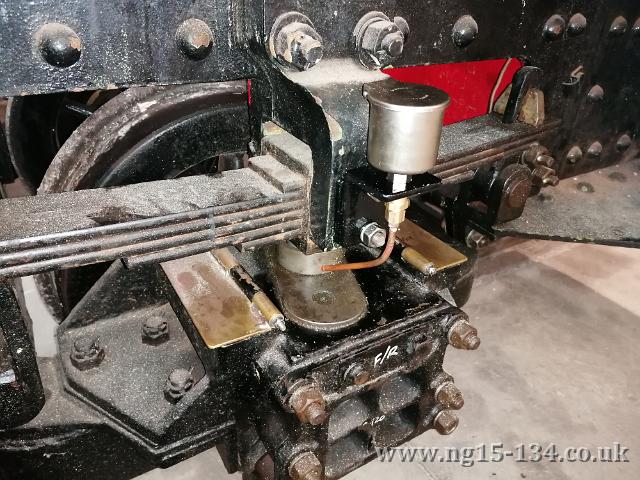 |
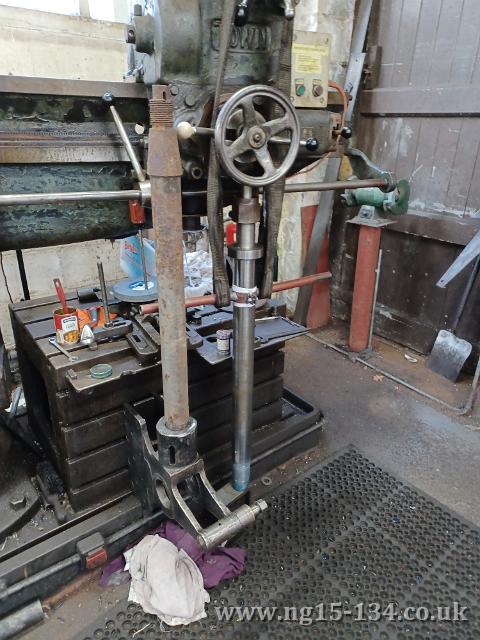 |
One of the new front pony
truck sliding shoe oil pots and support bracket, (left)
and the new piston rod design vs the original (right).
On the tender, we lifted the tender body off the frames to be able to get better access to work on the brake rigging. It also gave us the opportunity to review the lubrication method for the bogie center pivot and sliding shoes at the same time. With the new tender body not having the overhanging 'pannier' section to the water tank it makes the oiling system much more straightforward.
On the smaller jobs, and with the tender body lifted we also tidied up some of the plate work around the newly installed handbrake column and painted some of that area.
There were a number of other smaller 'cosmetic' being done as well and unfortunately as you'll see from this month's Gallery section, not much of it was photogenic! All good progress though towards the end goal.
To help with that goal we will be running a four day working party between Christmas and the New Year, the 27th to 30th December. Whilst it's not expected that everyone will be there all of the time, just the odd day or two's help will be much appreciated.
November 2022 Working Party
Whilst the boiler wasn't quite ready in time for this weekend due to difficulty scheduling in the boiler inspector to visit for a steam test at LMS in Loughborough what we can say is that steam test was passed and more details are on the Latest News page (link above). There is some finishing off to be done now as regards fittings etc but we're getting close..... watch this space!
In the meantime work continues on 134, and particularly that of the tender. Many of the jobs were continuations of those progressed or started last time so the first one to mention is the front hold down brackets for the tender body. We had some components laser cut for these and so they were duly welded in place over the weekend. Alongside this was that of the two water-boxes and the handbrake housing. The water-box is a sump arrangement that collects the feed water at the front of the tender. We'd had these made as fabrications and so they were also welded in place over the weekend. The fireman's side box also has the handbrake housing attached so this was welded in place as part of that exercise.
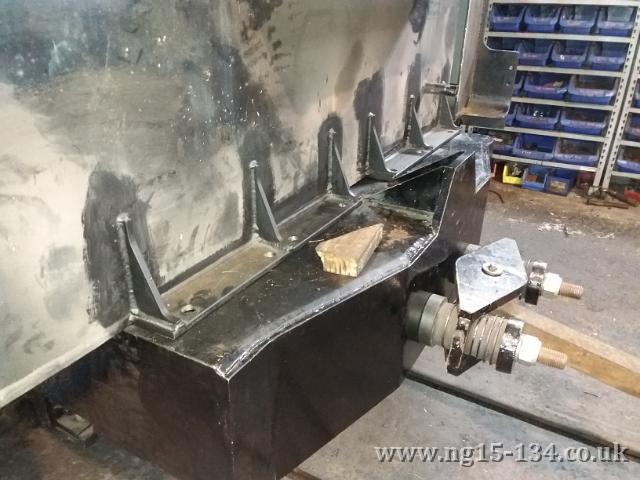 |
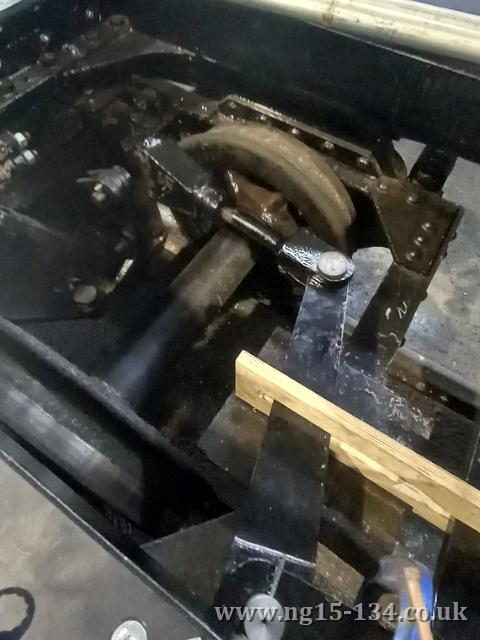 |
The new tender front
support bracket now welded in place, (left)
and some of the tender brake rigging in place and also showing the
trial support bracket (right).
The next big job being worked on is the handbrake rigging for the tender. This is slowly taking shape as we're trying to fit together all the various components that in some cases are no longer as per the drawing. Also some support brackets were missing so these were made in plywood to check out the whole arrangement before we have them made. Still work to be done but otherwise it's progressing well.
The full time staff have also been working on the loco and last time we left them with a kit of parts for the firehole door. This is now a complete assembly.
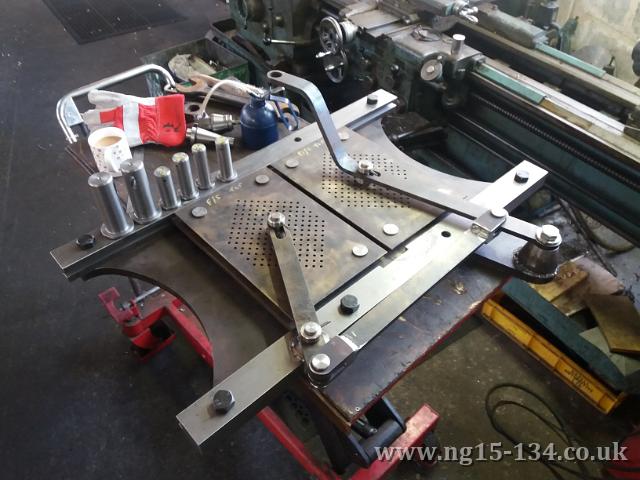 |
The firehole door is now a complete assembly.
For the loco we have now got a mock-up of the tender cab as mentioned in the postscript to last month. This will be fitted to the loco once the boiler is installed in the frames but in the meanwhile it was given a coat of black paint with the roof in grey.
Again on the loco, the rear cab floor frame extension that we'd had fabricated and that was painted last time was duly fitted and the steam brake was given an overhaul and refitted.
With the numbers we had for the weekend, that unfortunately didn't include your 'scribe' here as he was laid-up ill at home, we were able to cover a good number of the far too numerous to mention smaller jobs as well, but included things like finishing off the water gauge in the rear tender cupboard, cleaning wash-out plug surrounds and modifying the shoveling plate in line with the new cab arrangement.
The result being a very constructive weekend - again.
October 2022 Working Party - Postscript
On the Monday following the working party Adrian had the task of assembling our mock-up cab at Boston Lodge. This had been manufactured out of plywood and will enable us to test the ergonomics of the new design, and that we have adequate clearances up the line. Remember, 'Mother Earth' rears up much close to the track in Wales than it did in South Africa so extra checks are needed for our reassurance.
October 2022 Working Party
Our boiler is imminent and so this in all likelihood will have been the last working party before it arrives. One last job was done on the frames, however the majority of our effort during the weekend was applied to the tender and some components needed for the loco.
The main bits for the loco were dealt with were painting two fabrications needed for the new cab arrangement. This included the cab floor extension that was cleaned and given its first coat coat of paint last time. This weekend it had a second undercoat and a top coat. To go with this there is a rear low bulkhead and this was waiting for us having been fabricated at Boston Lodge. This was duly cleaned and then painted during the weekend.
Numerous other components were worked on such as the cylinder covers. These were cleaned and where no remedial work is needed duly given a coat of paint. The others will need some attention to repair some corrosion and to correct their shape. We gave our return cranks a clean and left these ready for the full time staff to review.
The brake rigging on the loco was progressed, although we're waiting for the last few pins that are now ready at Boston Lodge, and tried to establish the correct linkage length to meet up with the steam brake cylinder once the brake blocks are installed. The brake rigging for the tender was inspected to see what was needed in the way of new pins and bushes for that.
The new rear cab bulkhead
after painting, (left)
and yet more pipework added for the lubrication system (right).
Prior to the boiler arriving the last few lubrication pipes were installed across the frames ready for the fitting of the two lubricators on the running plates. There are also 4 oil pots needed for the pony truck sliding shoes and the mountings for these reviewed and in the case of those for the front truck, new ones made.
On the tender we welded down the headlight brackets onto the top of the tender and gave the welded area a coat of paint for protection.
All told a productive weekend as we push towards the completion of the loco.
September 2022 Working Party
This September weekend was set to coincide with the Society's AGM and so as well as the usual working party we had a stall of merchandise set out and were giving guided tours to show the current state of progress. That, unfortunately, didn't include showing the boiler sat in the frames as we'd hoped for last month due to a last minute hitch with it. The frames were however, moved to the goods shed in preparation for the boiler's arrival as outside the shed is more convenient for moving it off the lorry and into the frames. Also it made more room for the various locos that were to be kept in the loco shed as part of the AGM weekend and made the frames more accessible for the AGM visitors.
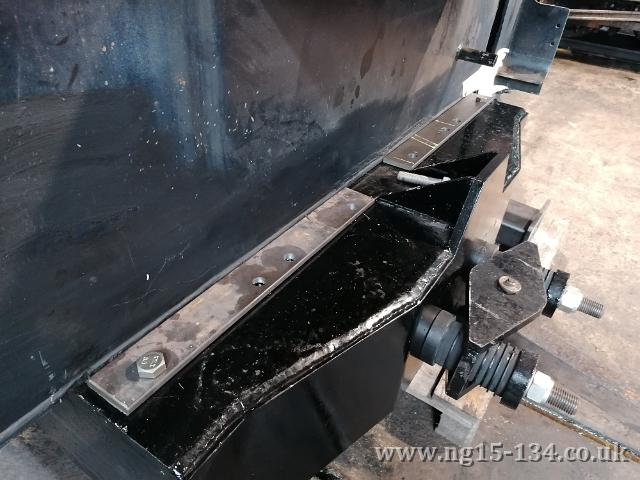 |
 |
The new tender body fixing
brackets positioned ready for welding, (left)
and the loco frames in the goods shed for the AGM and receipt of the
boiler (right).
The tender is still in the loco shed and this is where the bulk of the activity was taking place. Inside the tender tank, the change that was done associated with the vacuum cylinder recess in the bottom of the tank was seal welded on the inside for durability. This was then painted. At the front of the tank some new securing brackets were made and a start made on their attachment to the tender underframe. These brackets will need welding to the tank then some strengthening fillets added.
Some work continued on the two headlamp support brackets. The one for the front of the loco having the top sheet made ready. This will go off-site for riveting. The rear tender headlamp supports was also progressed
We're now in receipt of two sets of fabrications. The first is that for the waterbox and handbrake box. These are in two parts and will be joined together and welded into the tender tank, however we cleaned and painted them in preparation for that. The second fabrication is the rear loco frames extension associated with the new cab to tender arrangement.This again, after some final welding was thoroughly cleaned, dressed and painted.
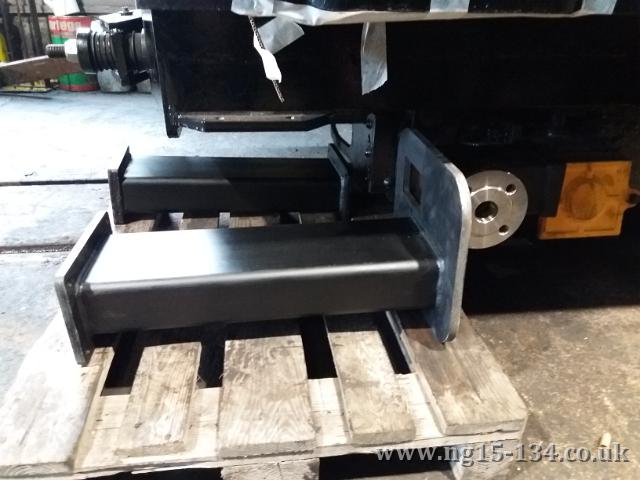 |
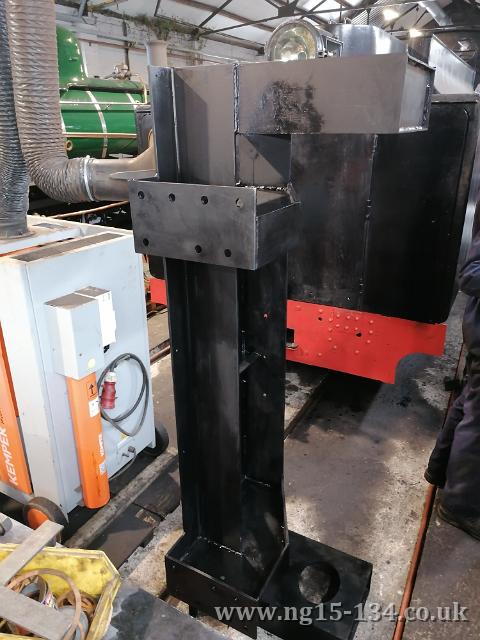 |
The tank well and
handbrake housing fabrications, (left)
and the rear footplate extension fabrication, (right) both after
cleaning and painting.
The brake rigging is another centre of activity with the components for the loco finally assembled. The rigging for the tender was then assessed and whilst we have the bulk of the larger components we'll need smaller items such as new pins so a start was made on these. Also some changes have been done in South Africa so everything is not strictly as per the drawings.
With the boiler not arriving it gave us better access to complete a fixing bracket for the lubrication network that needs to be routed on top between the frames and we then thoroughly cleaned the upper surfaces and give it all a fresh coat of paint.
In all another very good and constructive weekend, the only downside we have at present is that with all the paid work, and things like the fabrications mentioned above, we are in need of further funding to keep the project moving forward at the pace it is. If you can help then please head to here: https://www.whrsoc.org.uk/index.php/join-the-society-2/donations-and-legacies work where you can donate to the restoration of №134.
August 2022 Working Party
This will hopefully have been our last working party before the boiler arrives so many of the jobs on the main frames this time concentrated on areas of work where it would end up being more difficult with the 'kettle' in place. There was a lot of activity so a somewhat longer detailed report than normal.
Whilst there was plenty of activity on the frames there was also a lot of attention paid to the tender as well. One of those 'out of sight' jobs was with the nylon strips that act as a buffer to the tender frames. Last time we'd had the tender frames outside and in the rather sunny and hot conditions of the day some of the strips had expanded out of position. We therefore lifted the tender body to reposition these. At the same time as the tender was lowered back down we made sure that it was positioned as accurately as possible then the various holes needed to secure it in place at the rear were drilled and some bolts temporarily fitted to keep the alignment. We then started making the securing brackets needed at the front of the tender body.
The securing bolts at the rear of the tender are located in the rear compartment and this is also where we fitted a water level gauge. This is so as we can water the loco from ground level without having to go on top to the filler to see how much water is in the tank.
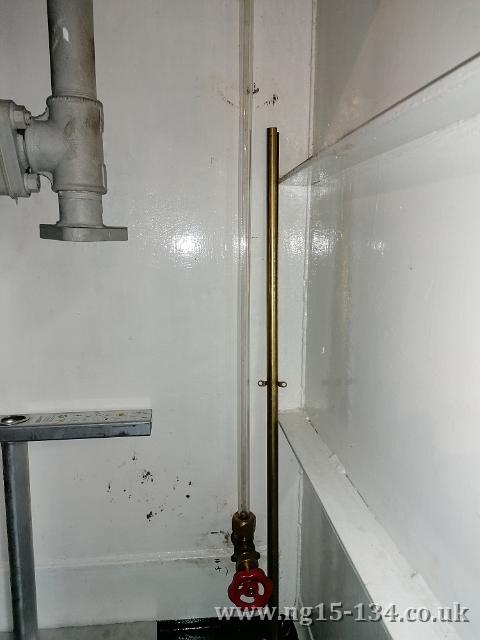 |
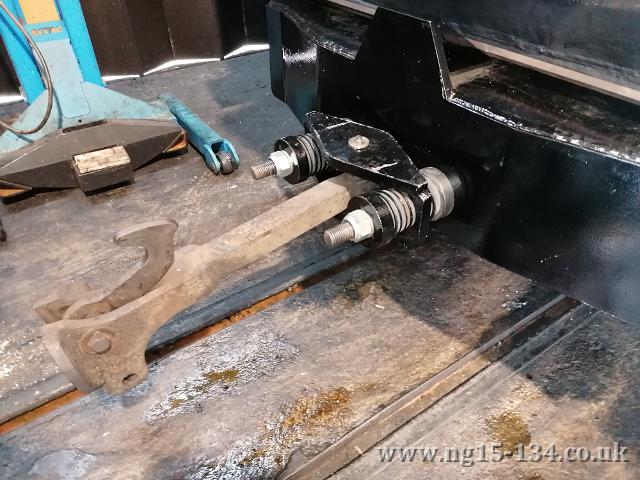 |
A water gauge was fitted
in the tender's rear storage compartment, (left)
and the tender's front
coupling with a temporary pin and chopper coupling fitted in place of
the final drawbar (right).
The couplings at both ends of the tender have also been attended to. We were missing some of the damping rubbers and a few other bits, although this was not preventing us from moving the tender in and out of the loco shed. The rear tender coupling is now finished and the front has a temporary chopper and pin in place until the time comes to connect it to the loco with the final draw-bar.
We had borrowed a lamp bracket last time, one that was destined for an NGG16, in order to drill the required mounting holes in the rear of the tender body. This time we therefore fabricated, painted and fitted our own bracket. Also being made were some brackets to mount the Pyle National headlamp to the top rear of the tender as well as the continued refurbishment/modifying of the mounting bracket needed for the front of the loco.
Back on the loco frames, one job that had been quietly progressed over several working parties was the refurbishment of the brake rigging. The volunteer doing this has made, or had made numerous components including new pins and bushes together with some of the rods being renewed or new eyes and adjusters fitted, as well as some of the small compensating brackets made as these were either missing or unserviceable. This is now very close to being finished so we can fit the brake shoes next time.
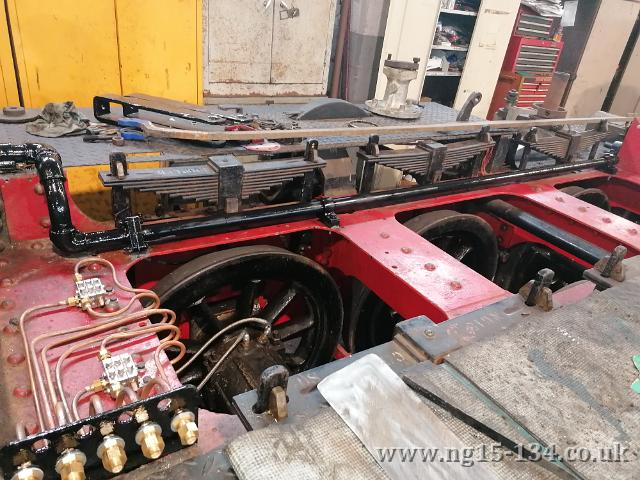 |
The vacuum pipe run across
the top of the loco was satisfactorily tested for leaks then painted.
Also in the view is the finished lubrication run from the Krauss
Helmholtz truck to the manifold plate that the lubricator will then
connect to.
Also finished was the vacuum brake pipe. We'd tested it last time and discovered some joints in need of attention. these were duly dealt with and the pipe run satisfactorily tested again. The pipe was then painted. Next being finished was the lubrication pipe run to the Krauss Helmholtz front truck and cannon box. There are a total of 5 places on the truck and 5 on the cannon box that all need lubricating so it did end up quite a complex system! This lubrication run takes the pipework to a manifold bracket on the fireman's side where it will then be connected into from the mechanical lubricator on that side. There is still some plumbing to be done occupying the same route across the frames. This will be for the steam oil lubrication for the piston & valve glands etc. We started a bracket needed for this however, the pipework can be fabricated with the boiler in place. Whilst on the Krauss Helmholtz truck we refitted the safety lifting bracket needed at the front of the truck as it had been removed to modify the front centering spring-box.
The full time staff had also been fitting the return crank to the fireman's side main driving axle crank pin and this had necessitated the tweaking of a couple of the brasses. These therefore needed re-greasing so we remove all the rods and took to opportunity to give these a last clean, paint their rear faces then grease them all for protection. The coupling rods also received the same attention with a coat of paint to their rear faces.
The ashpan door operating shaft was badly bent and this had been straightened last time so we were able to refit the shaft to the frames.
Also fitted was the cylinder exhaust drains. Again some work had been done in previous working parties, however in this time we fixed it all in place and added the drain pipe to lead any exhaust condensate away from the rail head.
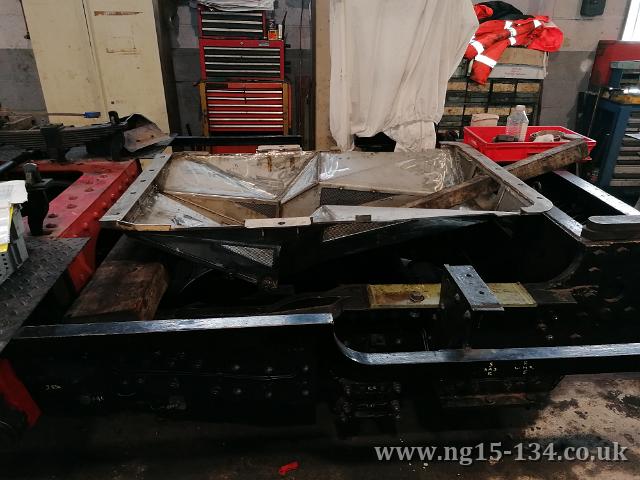 |
The ashpan being supported just above its final position ready to be bolted to the boiler.
On the Saturday we moved the ashpan to its position in the frames, although supported slightly higher, ready for attaching to the boiler when it arrives. Normally on the '15's the ashpan sits in the frames and the boiler's firebox fits above it but with a slight air gap between. This gap is unacceptable as a fire risk with the railway running through a very sensitive area so the ashpan has extra air vents and is sealed to the foundation ring on the firebox.
And finally to mention is that work is also continuing 'behind the scenes' at Boston Lodge where the modified rear footplate & and cab extension is being fabricated.
So overall an awful lot was covered this working party with good all round progress being made.
July 2022 Working Party
The July working party, as with some of the previous ones, started with a visit into the loco shed on the Friday afternoon to get things ready for the weekend, and to see what had arrived for us in the intervening time since the last working party. In this case what had arrived amongst the various materials that we'd ordered was the Pyle National generator that had been kindly donated to us by Peter Nott in the US.
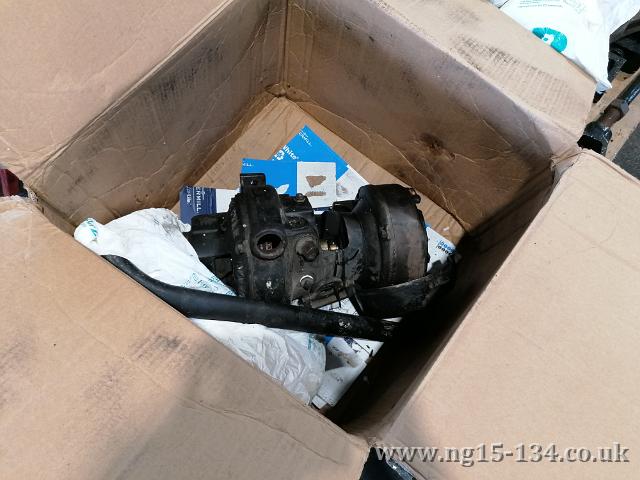 |
The Pyle national lamp just arrived from Peter Nott in the US, (left) and the new grills fitted to the stainless ashpan (right).
On the Saturday amongst a number of smaller jobs there were three main areas of activity. The first was that of cleaning all the connecting and coupling rods and giving them a coat of paint on the out of sight, inward facing side. The connecting rods were the worst for pitting and needed considerable 'elbow grease' to get them looking reasonable. The next area was the fitting of the ashpan primary air input wire mesh. Being a stainless steel ashpan this is not the simplest of tasks and even with a large stock of drills it still kept the chief drill sharpener busy, ie moi! The last main area of work was that of the tender where a modification to the tank for the vacuum brake cylinder was completed.
There were other smaller jobs progressed as well, such as that of continuing the lubrication pipework for the Krauss-Helmholtz front truck. This involved the fitting of two splitters on the main frames and the fitting of some pipework to connect these down to the already fitted flexible connections down to the truck itself. This is an ongoing job and there are a number of other pipes still to fit, preferably before the boiler arrives. Clive in the meantime was continuing with the vacuum pipe installation. Some new 45º elbow fitting had arrived to help with this. At the end of the day the pipe was tested under pressure for leaks.
martin had taken home one of the Pyle National lamps donated by Peter Nott where he was able to tidy it up and give it a coat of paint. This was returned and was positioned on top of the tender. The tender body was also drilled with two mounting bolts ready to take a lamp bracket and the tender number plate has a backing made and was duly fitted.Again on the tender modifications continued for the revised tender cab interface.
Much of this work continued on the Sunday however another job started was to prepare the smokebox mounted front lamp 'shelf'. This will need to be extended by an inch to take the Pyle National lamp as it was originally used with a Tonum and then the standard SA twin 'pre-focused' lamps.
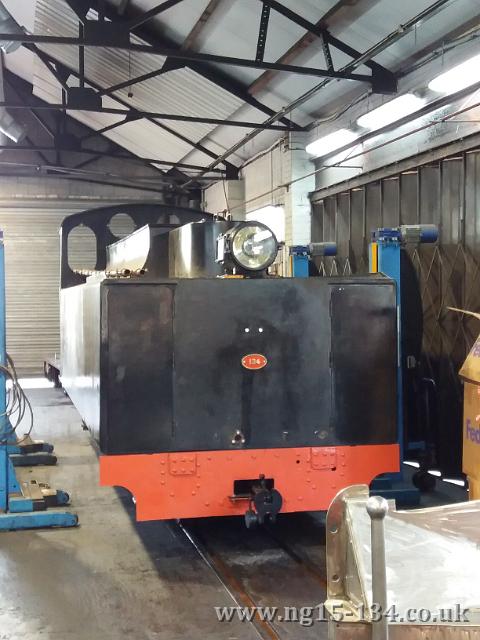 |
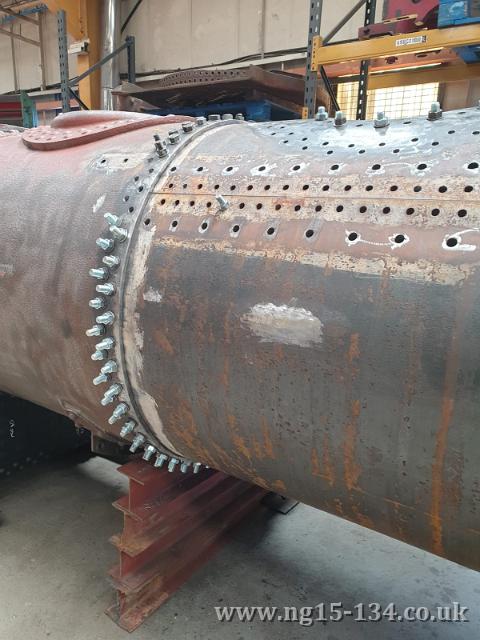 |
The rear of the tender at the end of Sunday, (left) and the new boiler barrel being fitted at LMS in Loughbororgh (right).
Over in Loughborough at LMS, our boiler continues to be progressed. After the trial fitting of the new front boiler barrel section a few weeks ago work has now moved on to the drilling of the barrel sections ready for being rivited together.
June 2022 Working Party
Whilst some of us attended the railway's RailAle festival the previous weekend, the 11th & 12th June, in order to do some preparatory work on 134 before the main working party took place the following weekend, the 17th to 19th June. This was a three day working party as on the Sunday some of us were attending a memorial train to Pete Randall our leader for this project up until 2020 when he unfortunately passed away. His funeral was held during the Covid lockdown period so only limited numbers could attend. This train was therefore arranged by Pete's family to enable those who knew Pete to attend the scattering of his ashes and the blessing of his memorial stone at Rhyd Ddu. As a number of us were unable to attend the working party on the Sunday we therefore did some work on the loco on the Friday to make up for the loss of that working day.
On the 11th & 12th June we were able to complete the painting of the modified front end to the frames, and to start to refit the tender axlebox covers that had received a further coat of yellow paint.
For the main weekend however, we had a number of tasks to complete. The main one was the greasing and priming of the coupling rods. The machining of these had been completed by the works staff and full time and so it was time to grease them all. All the rods were therefore removed and the bearings packed with the hard grease, the grease nipples were fitted and then each bearing further primed using the grease gun kindly sent to us by our friends in South Africa. A most vital piece of equipment to have so thank you guys.
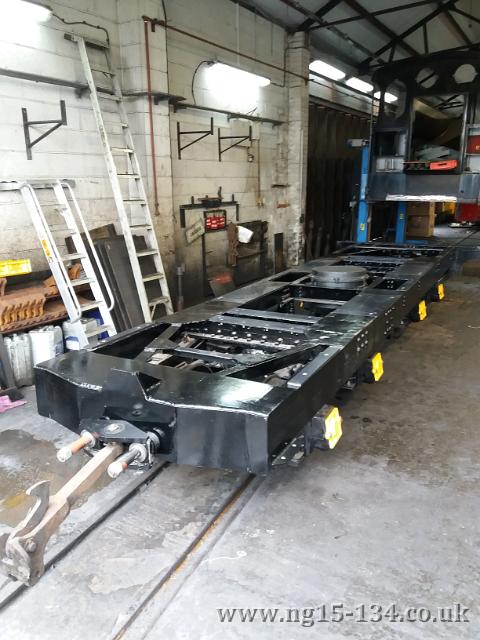 |
The coupling rods being primed with hard grease, (left) and the tender with its temporary coupling on the front (right).
As mentioned above we also finished fitting the tender axlebox covers. These look to have been originally fitted with a sealant of some sort, however for ease of access we decided to make and fit some nitrile rubber seals.
On the tender, the remaining nylon support strips were fitted to the frames and on the tender body one of the support brackets was removed that is no longer required with the redesigned tender-cab interface and the hole in the bottom of the tank needed to clear the vacuum cylinder was worked on. When built this hole was not quite aligned to the cylinder so this needed modification.
Back on the loco frames, the vacuum brake pipe run was progressed as was the lubrication to the Krauss-Helmholtz front truck.
Last to mention, that was on top of a number of other smaller jobs included straightening the ashpan door operating shaft that was horribly bent for some reason and attaching a temporary coupling to the front of the tender, was that of providing a couple more air holes into the ashpan. On a normal NG15 there is a gap between the bottom of the foundation ring and the top of the ashpan, however as we're operating through a National Park with a high fire risk we need to be very careful about spark and ash emissions to the track side - so such a gap is a no, no! The ashpan is therefore tight up to the foundation ring thus extra primary air inputs are needed to the ashpan.
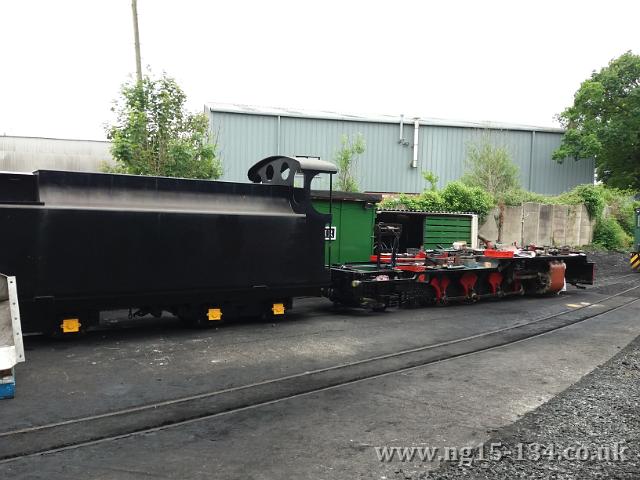 |
The tender and loco frames moved outside for Pete Randall's Memorial Train coming past.
The work on the ashpan continued on Sunday, however also on Sunday the loco frames and tender were moved outside for the passing of Pete Randall's Memorial Train. As Pete was our project leader up to his death it seemed fitting that those attending the train were able to see the progress on 134.
All told it was an excellent weekend with 13 of us there an the Saturday and once again plenty achieved.
Second May 2022 Working Party
The second full working party for May took place over the weekend of the 21st & 22nd. It was highlighted by the moving of the new tender tank from off 133's frames, where it had been since being built, and onto 134's now refurbished frames.
The last of the changes to 134's frame, this time the modifications needed to the front end to allow for the different cab to tender interface, had been completed during the week leading up to the working party. This left us with the new frame sections welded in place so the first task was to face these welds to make it look neater then give it a coat of paint. After fixing the bogie pivot securing clamps in place and fixing on the nylon buffer strip that the tank will eventually sit on as a buffer between the tank and the frames, rather than the plywood as previously used, we were ready for the swap. The tender body was pulled out of the shed to allow the lifting jacks placed in position. Once everything was in place the tender body was rolled back in, the body unbolted from the frames and the body lifted up. 133's frames were then rolled out from underneath and 134's frames pushed underneath from where they had been on the other side. An operation that went as well as could be expected.
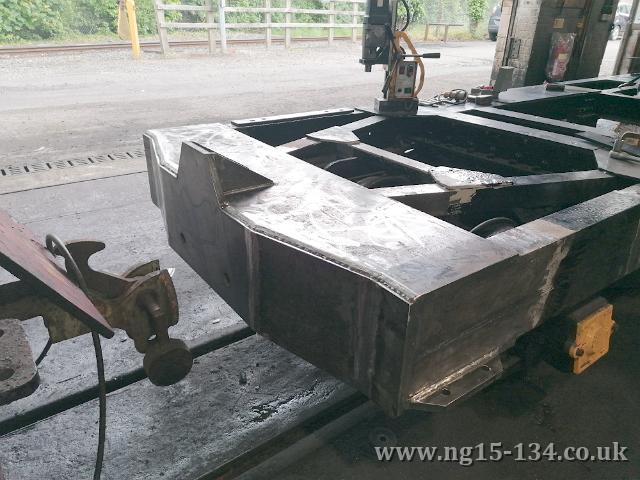 |
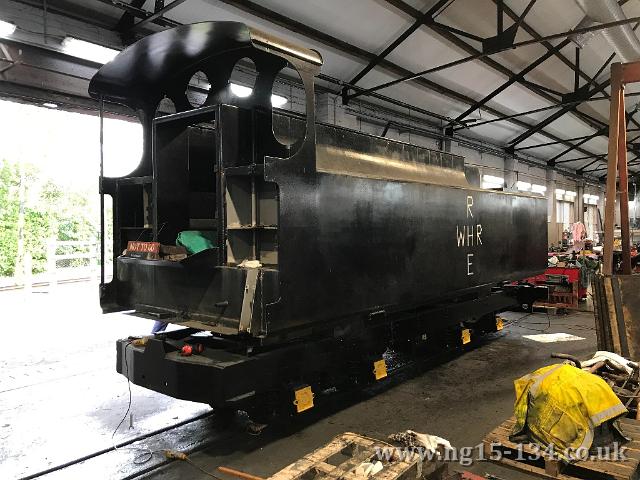 |
The newly modified front end to 134's tender frames after the welds had been tidied up (left) and the tender body now on its own frames (right).
We haven't lowered the body down directly onto the frames yet, instead it's resting on some sleepers on the frames, as we still need to finish the painting of the front end and to install the brake rigging and the couplings. We have all the components for the rear coupling and it was hoped to be able to fit this over the weekend, however, we had a feeling we were missing something so with it being rather strategic component we're double checking that its assembly is correct before fitting!
The tender buffer beam had a couple of (vacuum pipe) sized holes in it that are no longer required so we made some patches to plug the holes and these were duly welded in place. The welds were ground down to a smooth finish and then painted. It all looks so much neater now.
The tidied up rear tender buffer beam after the old holes have been filled.
There are a few other jobs to be done as well as those previously mentioned before the tank is lowered down permanently. Because 133's frames have a few differences in them to 134's frames and because of the updated new tender to cab interface it has resulted in there being a few fouling points that need to be addressed first. We did start on some of these but that work needs finishing next time.
Not everyone was focusing on the tender as we have a boiler arriving in the not too distant future and so there are also a number of 'critical path' tasks that are needed on the loco frames. One is that of the vacuum pipe and this was progressed over the Saturday. Hopefully this will be completed at the next working party. The brake rigging is being assembled as well. We was started last time as we'd had some new rods made, however we are still needing some pins and other components. We started making the pins and hopefully the other missing bits can be made for the next working party. Whilst not quite as critical, but still easier to do without the boiler in the way is the connecting up of the Krauss Helmholtz lubrication. We made a suitable bracket to go on the frames and the fittings on this will allow us to connect flexible hoses down to the various oil points on the truck and Cannon Box.
The brake rigging being trial assembled beneath the Cannon Box that now has its lubrication fittings in place.
Behind the scenes, work continues on the motion, that is now very close to completion, as well as all the design work on the newer tender to cab interface.
All told it was a weekend of excellent progress with many jobs we've been planning for coming to fruition.
First May 2022 Working Party
May will see two full working parties take place and the first of these was over the weekend of the 7th & 8th.
The weekend was preceded by a visit to Brunswick's to see the now ashpan that is being fabricated there. At the time it was almost complete and the intention is to take it the LMS to check its attachment to the boiler. After this it will be returned to Dinas and fitted into the frames as the boiler in effect sits on top of it.
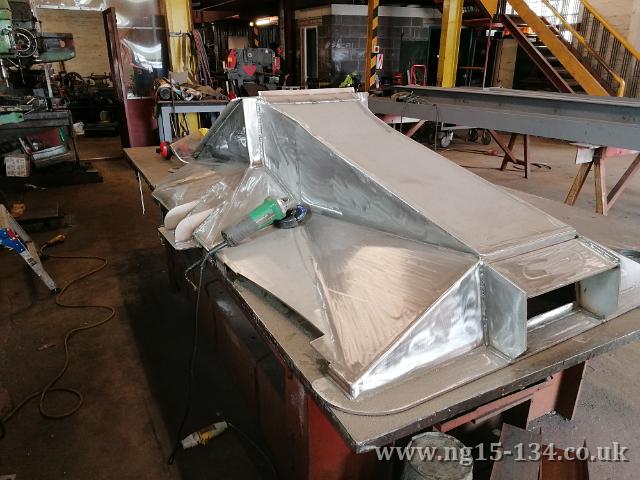 |
The new askpan at Brunswick Ironworks.
We have now moved out of the goods shed where the tender was being worked on and this now resides behind the loco frames in the Loco Shed. The modifications to the front of the tender needed for the revised tender to cab interface have been started and it is hoped these will be finished for the next working party. We will then transfer the tender body from off 133's frames onto its own frames. It will not be fastened down at this stage as we'll need to paint the modified area of the frames, as well as fitting the brake rigging. Talking of painting - yes still more painting - the last 1/2hour of Saturday was spent having a mass painting session to get the final gloss coat onto the rear end section of the tender frames.
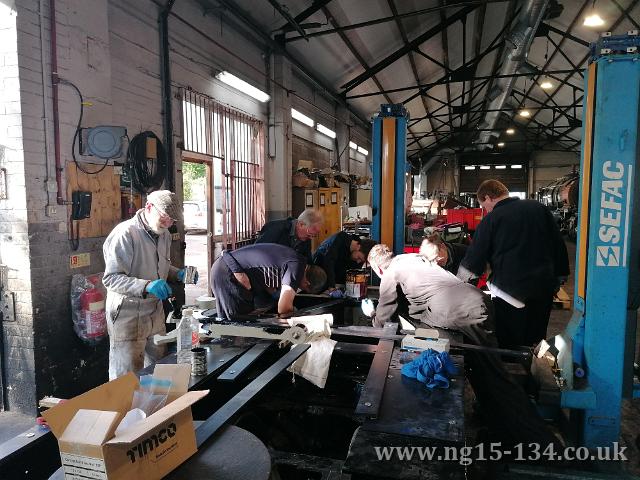 |
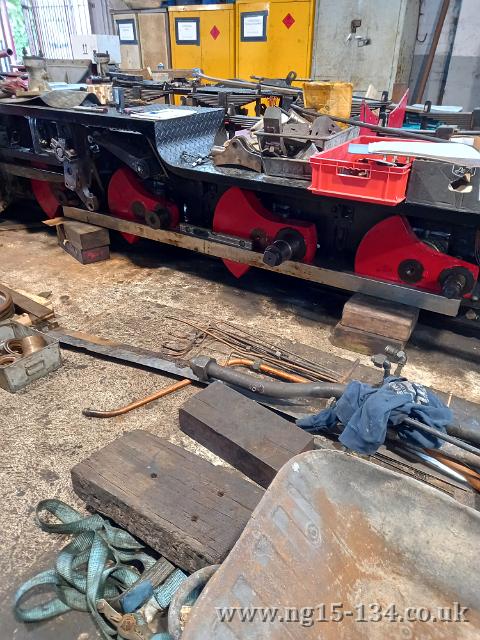 |
A mass painting session late on the Saturday afternoon (left) and aligning the loco driving wheel cranks (right).
On the loco frames, progress continues to get these ready to take the boiler. The full-time staff are working on the motion so we spent Saturday aligning all the cranks to make it easier for the coupling rods to be fitted and checked. We also did a stock take of the brake rigging after some brake rods had been made at Boston Lodge for us. We're still missing a couple of items that hopefully will be made before next time so as we're then ready to fit it all.
Other points of note following the weekend are that the valve liners have been re-bored since the April working party. These had been done early on however it was felt that some deterioration had taken place since so it'd be worth a skim over again. It did show up some deficiencies in the liners however they will still see a good bit of service with the loco. New liners will eventually be needed though.
The chimney was painted last time in our attempt at the South African grey and this is now ready to go to LMS for be fitted to the new smokebox.
April 2022 Working Party
The April working party again had a good turn out and was one that saw both the loco and tender frames dropped back onto their respective wheels.
It was a simultaneous re-wheeling with the volunteers splitting into two groups, one concentrating on the loco and the other on the tender frames. There were a number of smaller jobs to be done first though, such as fitting the main driving axle box covers that had been made over the previous two working parties and connecting the Krauss Helmholtz truck's internal lubrication pipework, to mention two on the loco, and fitting of the sliding shoes and covers for the tender's pony trucks. With those jobs done two groups lowered their respective frames onto the wheels, and, unbeknown to each other, doing so at the same time!
For the loco, once it was on its wheels there were various remaining tasks such as fitting the axlebox horn-keeps, fitting the Krauss-Helmholtz's safety bracket etc, but not before it was taken it for a short trip to the front of the Loco Shed and back to make sure all the wheels turned freely - that they did!
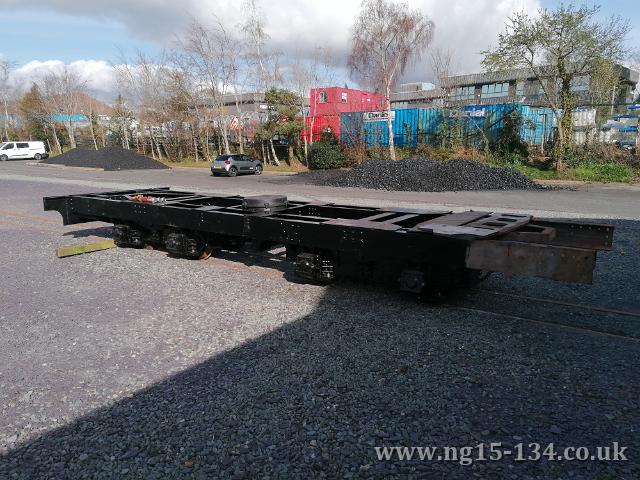 |
The loco (left) and tender (right) now both re-wheeled, and the tender with its Vac cylinder fitted.
On the tender frames we needed to make the bogie pivot oil seals and once done then the frames were lowered down onto its bogies. With that completed, it was taken outside the Goods Shed where we fitted the vacuum cylinder into its locating brackets. At this point we took the opportunity to give the shed floor a quick clean then returned the frames back indoors. Sunday was more of a painting day on the tender - yes still more painting to be done - as we continued painting the rear area where the repairs and modifications to the drag-box and coupling had been done. Just the gloss top coat needed at that end now then were even closer to being able to move the tender body from off 133's frames and onto its own frames.
We cleaned and painted the chimney after we had repaired the crack in the rim last time. We're attempting to get something close to the South African style of dark grey for the smokebox and chimney, so this was more of an experiment.
The connecting rods had some attention by cleaning and buffing them up as best as possible. This is work in progress.
As a last job on the Sunday afternoon, and in preparation for the tender body move, we transferred the jacks that had been supporting the loco frames over from the Loco Shed to the Goods Shed.
As there are a number of critical landmarks coming up at the end of May we have decided to hold an extra working party. This will be in early May, the 7th & 8th, so get it in your diary!
March 2022 Working Party
Another month and another working party but this time a slightly longer weekend working on the loco for some of us with an extra Friday spend at Dinas on top of the Saturday and Sunday. Overall there was plenty of activity on the engineering side as well as the inevitable painting that accompanies a project such as this as it approaches its final stages.
Most of the engineering was concentrated around smaller items such as finishing off the driving axle box oil pot covers. All the components were made last working party as so finishing off involved some removal of mill scale from the plates then some welding to fasten the locating pins to the covers themselves. This was followed by a couple of coats of paint. We also gave the crinolines a couple of coats of paint as a bit of protection even though they will be under the cladding.
The new cab windows mentioned last month were progressed again and it should be pointed out that Martin who is making these has also spent a lot of time working on them as a homework project.
The Vacuum Ejector was dismantled and cleaned and after a check over will be reassembled and whilst on brakes, the main train pipe to the front of the loco was progressed, or rather the hole through the front buffer beam was started.
The chimney is also being attended to. The chimney has quite a bit of damage to the casting in that there is a crack in the rim and it has lost most of its internal skit that the petocoat attaches to. A plan is in place to repair all the damage and this was started by repairing the crack in the rim. With it being cast iron and the crack non structural we decided to use high temperature (500ºC) resisitant filler. The crack was duly filled and shaped the following day.
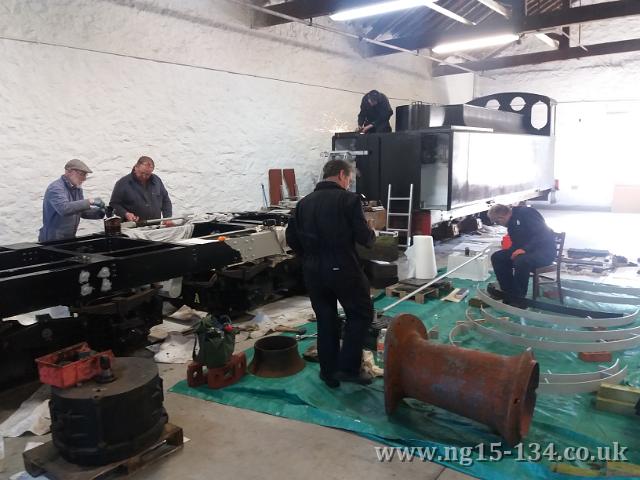 |
The tender receiving plenty of attention. (left) A crack in the chimney rim having been filled with high temperature filler. (right)
On the tender, there was activity around rear buffer beam and coupling by way of having the new patch welded into place and preparation made for the welding of the coupling housing into the drag box. The tender's body at the cab end was worked on to make the changes required for the new tender/cab interface and where the sandboxes will be positioned for rearward running. Then there was the aforementioned painting that was all going towards having the tender chassis ready for lowering back onto it bogies and the brake rigging assembled. The only bits awaiting a coat of paint will be each end of the chassis after the various modifications have been completed then it will be ready for the transfer of the tender body from off 133 old chassis.
We would also like to mention and give thanks to our home working helpers who have been beavering away behind the scenes to make sure all the on-site work runs smoothly, and that the loco will run smoothly in its new environment of the Welsh highland Railway. These include Dominic Wells who is designing and drawing many components for us associated with the couplings and cab layout, Dave Hatt who is modeling the 134's dynamic behaviour on the WHR route, Mike Ellis who is reconstructing our damaged chime whistle and Rod Strachan who is overhauling the steam brake and steam sanders.
All told excellent progress was made over the extended weekend.
February 2022 Working Party
Another well attended weekend with plenty of activity and many, especially the small niggling jobs, completed. This was following on from a few other odd days spent working on the loco by some of those unable to make the main working party.
Work is continuing on both the tender and loco frames, the tender frames being made ready for the transfer of the body from its temporary place on 133's tender frames and the loco frames being made ready to receive the refurbished boiler.
On the tender, during the weekend before the main working party the changes and repair to rear drag-box was progressed. The drag-box and coupling is being changed to the standard type and height needed for operation on the WHR so a badly corroded section of the drag-box is being replaced at the same time. This work was continued during this working party by doing some final cutting to shape of a new side piece for the drag-box.
Painting continued on the frames with some more coats added to the underneath section now the frames are raised off the bogies. We also continued the painting of various other components for the rolling chassis. The tank also received attention with the painting of the rear storage compartments. This is being done in white to aid visibility inside.
On the loco frames, various odd jobs were completed especially those made easier with these frames also being lifted up a bit. One such job for example was turning some bolts the other way up that were holding the 'top hat' cover on the Krauss Helmholtz pivot pin. We couldn't get these in when it was re-wheeled so they had to go in the opposite way. Not ideal so this was a good opportunity to correct that. We also added some split pins to these as well.
The tender rear drag-box repair is progressing. (left) The new driving axlebox covers being made. (right)
We needed to make some new driving axlebox oil-pot covers and so we'd had some profiles laser cut ready. These were progressed and duly had their locating pins made ready for welding in place together with the thumb-lifts added by bending up a corner on each side. We'll weld in the pins and paint them next time.
Some of the smaller jobs included finishing off the dismantling and cleaning of the cab's manifold steam valves, finishing off making and then fitting the safety lifting bracket for the trailing truck and getting the boiler's rear mounting expansion/support bracket ready. Whilst some new crinolines had been made during one of the very early attempts to restore the loco these had suffered a bit in the interim. We therefore needed to replace some corroded stand-offs and then paint those. Another job made easier by the lift was to block a hole in one of the pony truck axle boxes to prevent ingress of water into the axlebox.
The vacuum pipe at the front of the loco was progressed. We now need a hole for its passage through the buffer beam then the pipework can be progressed to join up with pipework run already made.
Finally we have an ongoing homework project being progressed for the cab's windows. We've received the new castings for the rear round windows in the cab back on the tender. These were worked on during the weekend in order to get the correct fit with the hole in the cab as well as to work out the hinge mount.
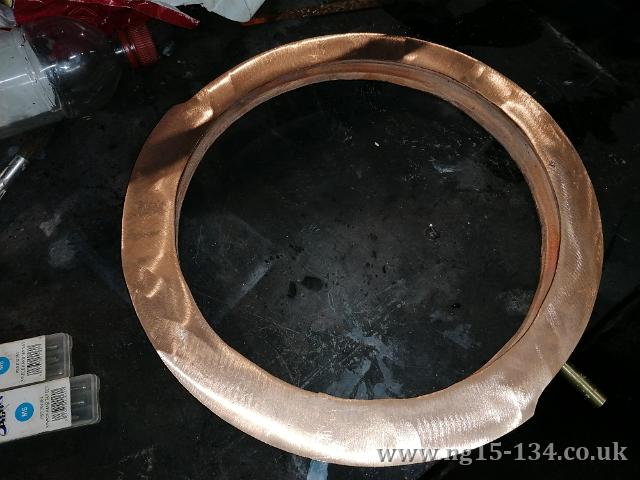 |
The cab's rear round window casting.
January 2022 Working Party
The first working party of 2022 was held on the 22nd and 23rd January, however, since the main December working party of 2021 some of the group were able to attend for a few days between Christmas and the New Year. The focus on these days was to be more as a preparatory working party to ensure that everything was in place to make sure that the first few working parties of 2022 got off to a flying start.
And a flying start it was with the January working party with not far off 15 of us attending on the Saturday and although slightly fewer on Sunday it was still a very good turnout and illustrates the momentum the project now has. So where to start as there's so much to report.
We currently have the tender frames in the Goods Shed at Dinas and the loco frames in the Loco Shed so this gives a natural split to the work activities. In the Good Shed the tender frames were lifted off the bogies and securely packed in the days mentioned above between Christmas and New Year. This was so as we could get access to painting the underside of the frames and so as work cold take place on the front and rear drag boxes. With some painting already having taken place after the lift at the end of December this was continued on this working party.
Saturday of this working party also saw the removal of the rear coupling and drag box sections. There was considerable rot in this area and in view of us also needing to alter the coupling height to the FR/WHR standard it was decided that replacement was better than a repair/modification approach. Once the new drag box is in place a standard FR/WHR coupling assembly will be fitted.
The tender rear drag-box undergoing 'improvement'! (left) - and the removed sections (right.
Other activity in the Goods Shed centred around the brake linkages where these were cleaned and painted and an assessment made for whether any new pins and bushes were needed.
The chimney for 134 was also in the Goods Shed and this was being subjected to a bit of high tech evaluation. We're missing around 3/4 of its petticoat and so we're looking at options as to how to remedy this. As part of this exercise we had the whole chimney 3D scanned so as we have a complete computer image of the component as all the drawings do not fully illustrate all the compound curves associated with its casting.
In the Loco Shed work on the main frames also continues. The jacks are now positioned around the frames and so we are in the situation where these can be raised for better access to allow other work to continue. This included the clearing out of the exhaust steam pipe drains. It didn't look like any fittings and drain pipework had been in place for some time so any condensate had been allowed to drip straight onto the lower section of the smokebox saddle casting causing a significant amount of corrosion. The threads to the drain were cleaned out ready for new fittings to be made and inserted.
We're now in the third iteration of the train vacuum pipe run as it was thought best to have the pipe end in a similar position to those the NGG16s. A new bracket was therefore made ready for the pipe to be relocated.
We also had the valve cylinder liners investigated as they did not look to be matched. It turns out the liners on one cylinder are incorrectly positioned. Probably when the liners were replaced and frozen shrunk into place. Likely they didn't get all the way in before they expanded and became stuck. All it means is that we'll need to have a non-standard valve rod to hold the heads in a slightly different position to drawings. They will eventually need a light skim to remove some noticeable pitting so this will be done in the next couple of months.
One other big job was the removal of some support brackets on our motion. These had been sent away to a specialist contractor to have the rod ends refurbished. These were built up with weld where needed then machined to be square and positioned 'to drawing'. This involved attaching (welding!) some rather large steel brackets to the rods so as they could be accurately secured in the machine. We therefore had to cut the brackets off and then carefully bring the rod back to their original finish. That took two us a good half a day to do!
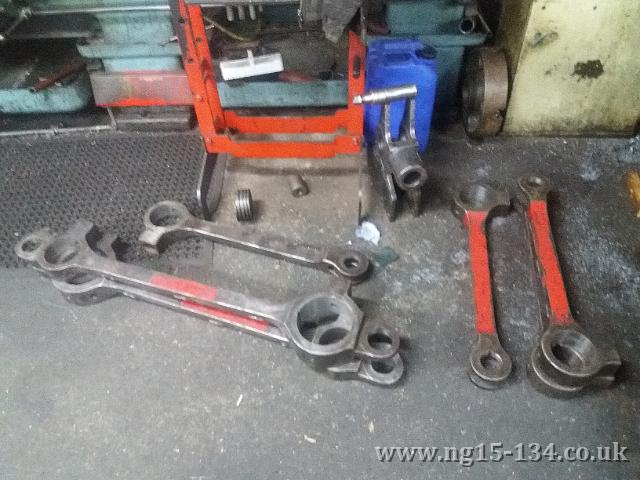 |
The motion being tidied up of the support brackets following remedial machining.
Other work included the assessment of the brake rigging and painting the pieces we have.
All told an excellent and productive start to the year, with hopefully many more to follow. This was helped by, and with thanks to, our other colleagues with the specialist skills needed for the jobs this weekend such as the scanning of the chimney and valve liner assessment.
The earlier working party reports going back to 2008 can be found in the Archive